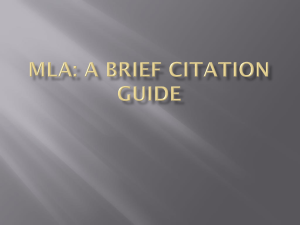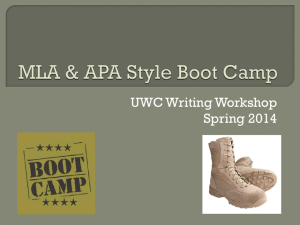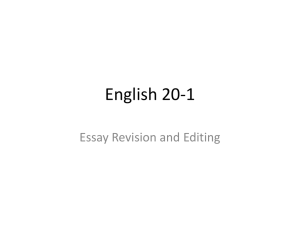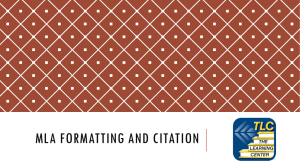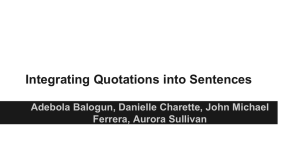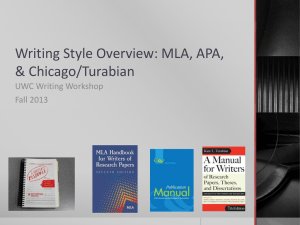MLA In-Text Citations
advertisement
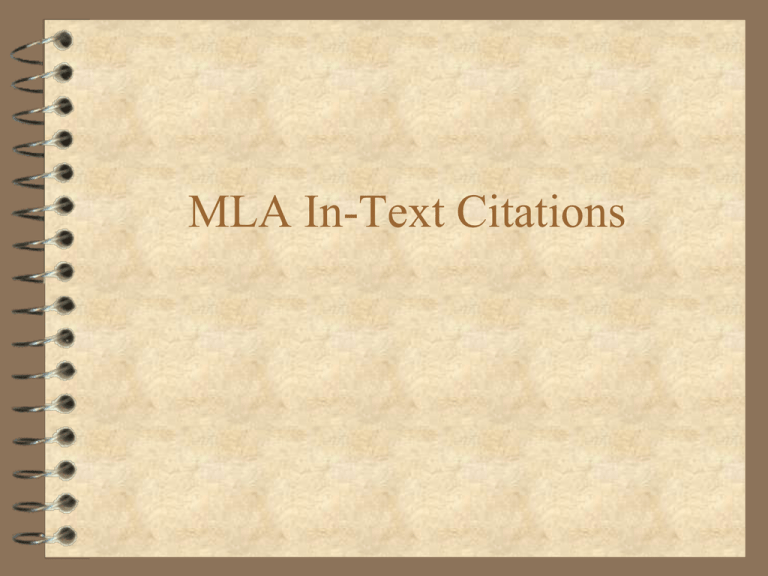
MLA In-Text Citations Your purpose in writing is to: build and construct your own pattern of meaning develop your own ideas create your own organization reach your own conclusions You should: use outside sources intelligently to strengthen your text with necessary support and evidence cite outside sources correctly You should not: simply parrot back what those sources tell you. fail to give proper credit to the sources you use. Citing Sources: shows your indebtedness to the work of others. gives the reader a chance to find further information. builds your credibility as a writer and researcher (ethos!). Why do I need to cite sources? You need to distinguish clearly between your own words and ideas and those of others. You should give credit where credit is due. There is no penalty for documenting. Failure to document is plagiarism. You must cite: Quotations -- Taking from another source the exact words of the author and using them in your work. These words need to begin and end with quotation marks and should be cited. Note: Quoted material is not just something someone said. Direct quotes can be used to capture the exact wording of any information in a source. When should I use direct quotations? Most often you should paraphrase and summarize source material. Quote only when you want the exact words of a source for some important reason. Keep quotations as brief as possible. Only rarely are extensive quotations of more than 4 lines necessary. Good reasons to quote from sources: For support -- to bring the voices of experts into your paper. For vivid language -- the wording of the original sources is clearer and more effective than any paraphrase you could write. To represent the source fairly -- when you quote accurately and directly, no one can claim you misrepresented the source. A well-chosen quotation: must be more than a random selection from a source (it’s not filler!) should say something significant or important enough to be quoted. should be well-written. Don’t over quote Use quotations sparingly (for example: In a 5-page paper, 2 should not be quotations!) Don’t let other voices dominate your paper Don’t build your paper by stringing together other people’s words. Quotations offer evidence and support; they are not a substitute for your own ideas, arguments and assertions. You must cite: Facts that are not common knowledge If you can find the fact in multiple sources, it is common knowledge and you do not need to cite it. For example: the population of the United States, the chemical formula for water, the number of planets in the solar system, etc. You must cite: Paraphrase -- Short passages (two to three sentences) from a source that you have rephrased in your own words. Paraphrased material is not enclosed in quotation marks. You must cite: Summaries -- Taking lengthy passages from a source (multiple paragraphs or more), and reformulating or outlining them in your own words. Summarized material is not enclosed in quotation marks. MLA In-Text Citations Basic Format (Author’s Last Name (space) Page Number) One author claims that “no one is concerned with this issue” (Jones 45). No comma between name and page # Close quotes before citation; period goes outside the parenthesis MLA In-Text Citations Basic Format If the author’s name appears in the introduction to the quote, then only a page # is required. Howard Jones, director of the National Institute of Alien Abductions, argues that “no one is concerned with this issue” (45). MLA In-Text Citations Web Sources Treat citations for web sources and on-line data bases the same as you would for printed works Fixed page #’s generally not available Omit page #; don’t use page number from print- out DO NOT PUT WEB ADDRESS IN CITATION!! MLA In-Text Citations No Author Available If no author is available, use a short form of the title Title of the article: “Thirty Reasons to Write a Research Paper” Citation looks like: (“Thirty Reasons” 26) Title of the Book: Ultimate Guide to the Simpsons Citation looks like: (Ultimate 567). MLA In-Text Citations Multiple Authors Both names included; joined by the word “and” (Cortez and Jones 56) Three or more authors, use first author’s last name followed by the abbreviation “et al.” (Cortez et al. 378) MLA In-Text Citations Different Authors; Same Last Name Include enough information to differentiate them (H. Jones 48); (O. Jones 36) MLA In-Text Citations Multiple Works by One Author Author: Howard Jones Book Title: The Man of the Hour Magazine Article: “The Destruction of the American Mind” (Jones, Man 475); (Jones, “Destruction” 34) MLA In-Text Citations Group Authors Group authors like corporations, professional organizations, etc. Use same format, but substitute group name (American Heart Association 68) MLA In-Text Citations Indirect Source (a source quoted in another source) Use abbreviation “qtd. in” Musician Miles Davis quoted in an article by Nat Hentoff In one interview, the jazz legend said, “I never took formal music lessons” (Davis, qtd. in Hentoff). Miles Davis once said, “I never took formal music lessons” (qtd. in Hentoff). MLA In-Text Citations Bottom line: An in-text citation must match up with the first word or few words of your works cited entry--author’s last name or shortened version of the work’s title Rychnovsky, Ray. “Clawing into Controversy.” Outdoor Life Jan. 1995: 38-42. (Rychnovsky 41) “Lion Attacks Prompt State to Respond.” New York Times 18 Oct. 1995, late ed.: A21. (“Lion Attacks” A21). Integrating quotations: Attribution Introduce all quotations so the reader knows who is being quoted—include the speaker’s credentials! Don’t rely on parenthetical citations to convey this information. Integrating quotations: Providing commentary Don’t assume your reader sees the same significance in the quote that you do Don’t leave the quote “hanging” or “quote and run.” Integrating quotations: Providing commentary Your reader must understand why you have chosen a particular passage to quote. Your reader must see the significance of what it says Your reader must know what you want him/her to take from the quote. Remember the OREO rule Step One: The Cookie -- Start with a few sentences, building up to and explaining the quote and why you are using it. For example: Most often, families that are dysfunctional are the ones that spot aliens. Sighting aliens has been characteristic of abusive, single-parent, or low-income families for years. Many scientists have documented this overwhelming phenomenon. Remember the OREO rule Step Two: The Cream -- Once you have built up to the quote, you are able to smoothly insert the quote into the context. For example: According to Dr. Alvin Goodchuck, Ph.D., world-renowned family psychologist and NASA consultant, “We’re seeing that time and time again, dysfunctional families are at least ten times more likely than any other familial structure to sight aliens” (216). Remember the OREO rule Step Three: The Cookie -- Now you may explain the significance of the quote and make it clear what you want the reader to take from it. For example: With such overwhelming rates of dysfunctional families spotting aliens, it is not only safe, but correct, to say that aliens are choosing the types of families they visit. Putting the OREO together Most often, families that are dysfunctional are the ones that spot aliens. Sighting aliens has been characteristic of abusive, single-parent, or low-income families for years. Many scientists have documented this overwhelming phenomenon. According to Dr. Alvin Goodchuck, Ph.D., world-renowned family psychologist and NASA consultant, “We’re seeing that time and time again, dysfunctional families are at least ten times more likely than any other familial structure to sight aliens” (216). With such overwhelming rates of dysfuntional families spotting aliens, it is not only safe, but correct, to say that aliens are choosing the types of families they visit.


